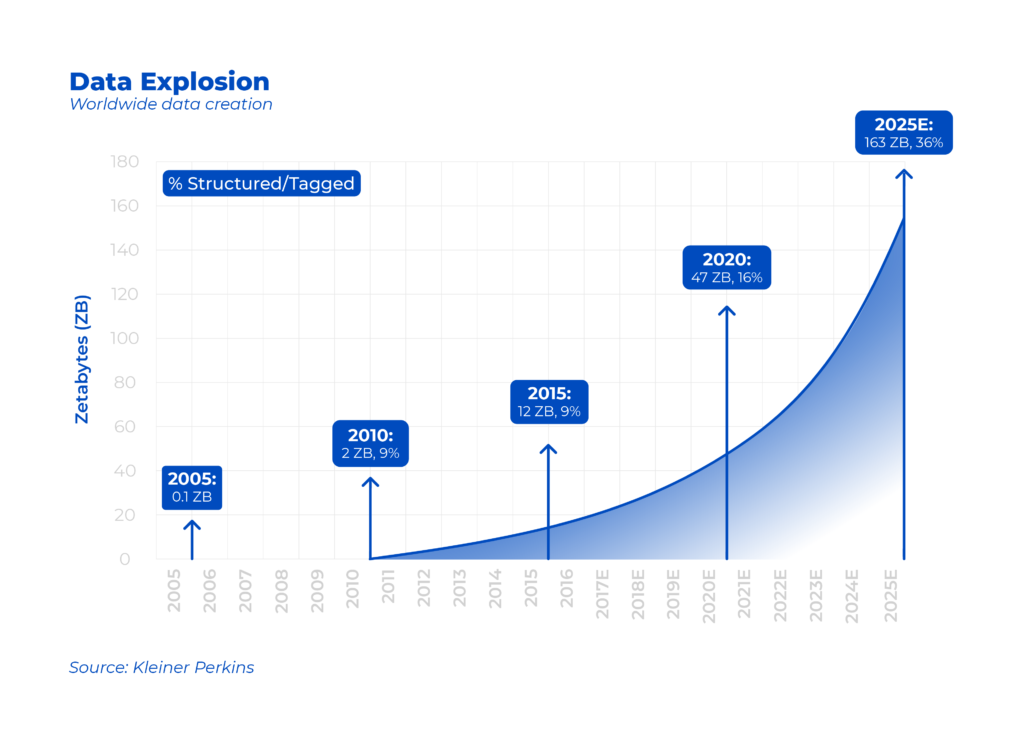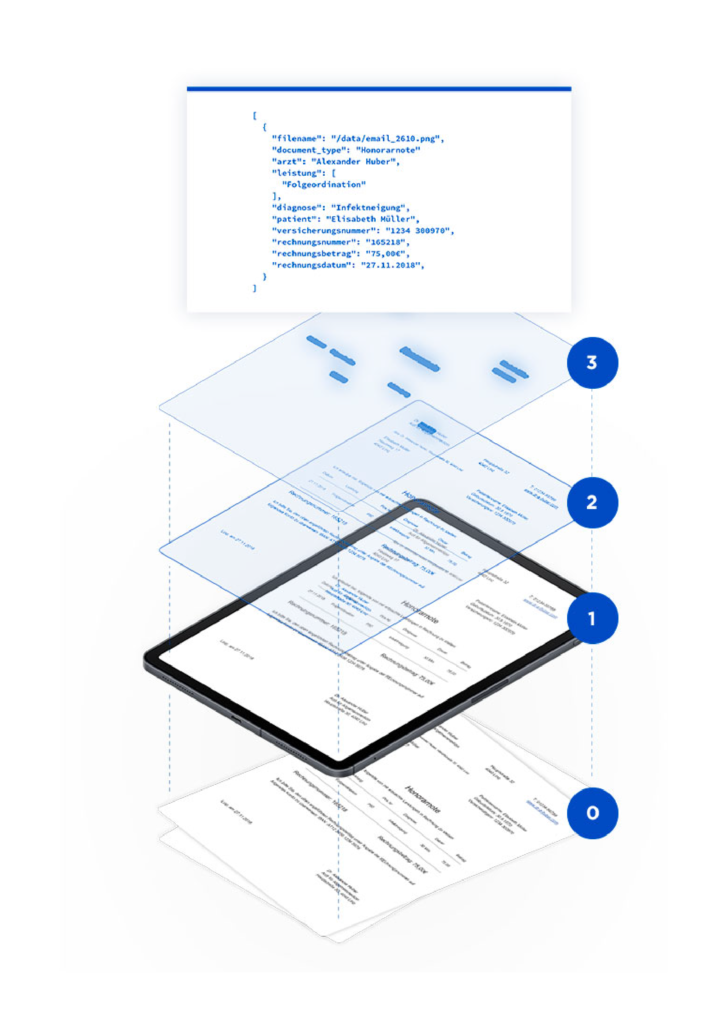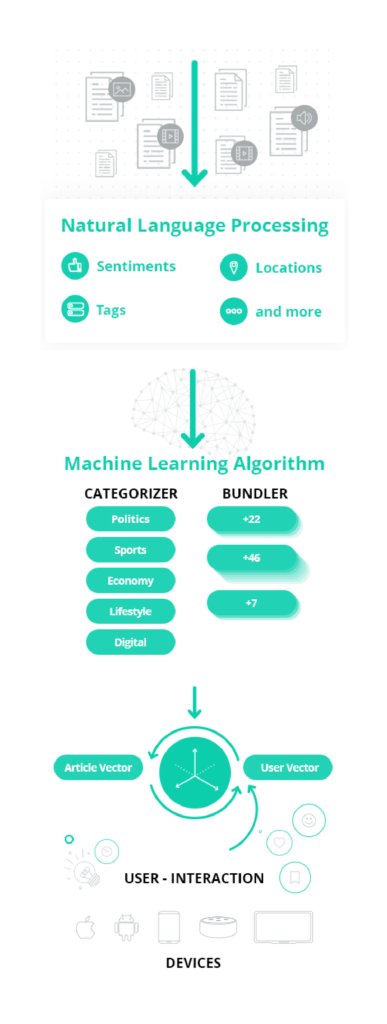A bookworm perspective to digital content assets
The digital shift from operation to information
The remote ecosystems of workplaces have significantly intensified data exchange across online environments. Clients are now sharing sensitive information through dedicated portals rather than face-to-face customer service. A growing number of businesses have adopted SaaS collaboration tools as an extension of the home-office setup. Remote interactions now require ad-hoc knowledge distribution systems which can provide faster and more reliable sources of data management. This environment further intensified the digital shift from an operational construct to an information management one.
As 90% of the existing world´s information has been created in the last two years and even more is generated every day, data scientists and business owners need to frequently reinvent their system architectures to channel and harness the overflowing amount of knowledge circulating in the digital environment.
The path beyond digital libraries
Non-retrievable or hardly accessible data can be dangerous for a business wasting time and resources to seek or elaborate such information. Service provider´s SLAs, enterprises´ intellectual property rights but also buyers´ profiles are few of the examples of this sensitive knowledge companies need to protect but at the same take advantage of. They are part of the ecosystem of Knowledge Management (KM), whose central focus is transforming intellectual assets into business value.
Years of enterprises focusing on customer relationship systems and information storage have reduced such a complex concept to the one of a simple database system where information is labelled and stored in digital libraries. Not that far from the idea of a diligent librarian meticulously putting books on the shelves in alphabetical order. However, just as the books placed in the library, stored information in companies´ databases does only partially serve its entire purpose. If publications are not read – therefore knowledge is not shared or used – those books, just like the digital data, remain an untouched resource.
New technologies are reinventing the value of these assets, transforming stale data into knowledge that can be manipulated and turned into a business resource. Artificial Intelligence is currently the domain allowing Knowledge Management to shift its scope to an information engineering ecosystem where content is reconstructed and elaborated by dynamic and adaptive techniques closely resembling the human cognitive information process.
Artificial Intelligence reinventing the world of data
The recent booming of data discovery, management and visualization, as well as business analytics in the professional context reveals a data-oriented perspective highlighting the growing importance of information-oriented business environments. However, in the attempt to harness the power of knowledge, human mental processing capabilities fall behind when confronted with the vastity of the already existing digital content.
Prominent technologies such as the Internet of Things (IoT), Machine Learning (ML), and Artificial Intelligence (AI) therefore emerge as significant tools to collect, elaborate, and transform massive volumes of information in a short period. AI has – through different iteration mechanisms – already found different methods to unlock and give new meaning to digital knowledge to improve the decision-making processes of business entities. The most relevant include:
- Pattern recognition
Machines elaborate unstructured data and sort it into identified classes (commonly known as categories). They can easily connect system-stored concepts with knowledge sharing a similar context or environment. The system can learn from these newly discovered connections and – just as the human mind association – gradually improve in recognizing existing links between digital data.
Missing links within existing knowledge make companies lose strategical value – information-driven associations are one of the biggest hurdles in handling big volumes of digital knowledge. As we sometimes read books but forget about a similar concept handled by an article we read two days ago, the same happens within business architectural infrastructures.
Companies often fail to create data-friendly environments. This makes it difficult to spot the connections between the information of different ecosystem components within the firm and between parts of a single component. These connections are frequently the ones playing a crucial role in making a data-driven decision which ties strategic planning to reliable analytics insights. They are also the drivers that enhance value within the information management environment of an organization.
A new ecosystem of smart memories – when confronted with ´digital knowledge´, many immediately picture online libraries filled with statistics and condensed materials in the form of text or numbers. If anything, knowledge management has proven that ´data´ is a loose terminology. Even a photograph can be a piece of information hiding a significant business value, as the Smart Moments mobile app of HappyFoto has proven.
The solution involves an AI system capable of grouping together images of similar types – such as selfies, landscapes, or group pictures. The intelligent system of face recognition and image classification eases the arrangement of these categories in chapters that are photobook ready.
On the one hand, users are freed from the time-consuming task of scrolling through their phone libraries, sorting memories, and selecting shots for print. On the other, the HappyFoto company can now profit from meaningful (anonymous) data from the app which displays customers´ ordering behavior. Not only did the technology of pattern recognition improve the efficiency of the photobook process, but new knowledge was generated from the algorithm derived from computer vision. This knowledge is the added value in form of data the company is now using to plan its business strategy.
- Anomaly detection
In the data analysis process, AI technologies can identify outliers within datasets. Atypical knowledge behavior is isolated from the group of information and identified as rare or suspicious. Just like pattern recognition, the environment can be configured to be autonomously improving through continuous learning from data streams.
Data inconsistency can be an indicator of ecosystem malfunction – in most cases, articles with evident contextual mistakes deviate the readers from the storyline. They realize there is something wrong with the reliability of the narrative: the provided information is now untrustworthy.
Companies´ pools of data work similarly. Inconsistencies within datasets can directly affect the knowledge within these information pools and therefore create significant hurdles in the workflow of business processes. These often present themselves in the form of financial transaction fraud, cybersecurity scams or production line disturbance.
Natural language processing (NLP) changes the game of reimbursement systems – NLP is the key technology supporting AI in interpreting and evaluating the human language. Its ability to study and classify online documentation is a decisive factor in the anomaly detection process of knowledge volumes. Considering these effects on information management, the collaboration with itSV GmbH gave birth to an NLP-driven AI system which can scan and classify information within the paper load of the Austrians’ medical expenses reimbursement system.
The overflowing volume of information included in handwritten medical bills of an entire country can easily fall in the trap of data inconsistency. Contextual and environmental factors indeed increase the chance of missing signatures and incorrect values within the documentation. The AI processing system created an algorithm capable of associating existing categories in medical invoices (such as IBAN, doctors’ signatures or handwritten comments) with the text these documents contained.
The document classification and validation system easily detected incomplete or incorrect information by filtering the knowledge by content type, be it for contracts, orders, or receipts. The NLP´s anomaly detection system for reimbursements was the turning point to reduce the manual processing of paperwork – and therefore the chance of errors – to a mere confirmation of results already provided by the AI.
- Knowledge delivery
Online databases can provide AIs with knowledge baggage spanning across different areas and fields of application. A well-configured machine can attain from a repository of real data which increases with the number of interactions with users that feed new information to the algorithm. This means new knowledge intake and therefore a wider pool of data available to customers or systems users.
The act of information delivery (or transfer) is frequently performed by chatbots: artificial technologies based on NLP which analyze and interact with the human language through a conversation-like simulation environment.
Difficulties in retrieving information can lead to significant customer losses – knowledge availability is an often-underestimated factor playing a crucial role in service users´ satisfaction. Readers missing sections from a publication might understand the paragraph they’re concentrating on but at the same time lose the bigger picture of the paper. Similarly, customers navigating a website, using an application, or trying a new service cannot take advantage of the entirety of the solution if instructions on how to navigate the system are not easily retrievable.
Forgetting to enable this knowledge transfer can therefore easily result in users stopping the use of the solution as they feel the support team is not attending to them, or that they’re employing only a limited number of existing features because of poor communication on system management. Knowledge delivery hereby plays the role of an information bridge between customers and infrastructures. When parts of this bridge are missing, the direct connection between the two parties also breaks and part of the value transferred within this information ecosystem gets lost with it.
The smart travel assistant – businesses often forget that knowledge access can play a significant role in the customers´ experience. Client support is indeed nothing more than a virtual information-sharing system. This system needs to be efficient and proactive: the more availability of guidance in form of data, the lesser the risk of breaking the existing connection with the user.
Zoey virtual assistant is an example of a solution that understood the importance of these links. Travelers are given the option to be supported by an NLP-based chatbot after making holiday reservations. The solution becomes an on-demand companion providing tourists with essential information during their vacation.
A local vegetarian restaurant. The top sightseeing locations in the city. The perfect beach for a family. These and many more become relevant pieces of knowledge enhancing the puzzle of traveler experience. Chatbot users do not feel abandoned right after placing a reservation but find a travel companion supporting them in their everyday holiday needs.
The information system enhances the value of the booking experience and further refines its precision through past interactions with users, thus providing increasingly more accurate and customized conversations. AI´s chatbot solution has not only eased the job of support centers by decreasing the amount of contact points but also created a more personal and long-lasting interaction with the customer through the simple use of data transfer.
- Information processing
AI pushes pattern recognition categorizations a step further and uses it to convert the collected data into new sources of connection within the dedicated knowledge ecosystem. NLP language hereby supports content processing in various forms including intelligent tagging or sentiment analysis. In short, the technology can collect the categories derived from the pattern recognition procedure and manipulate the data inside them to produce additional value.
This mechanism relies on Machine Learning (ML): the art of training machines through algorithms for them to be autonomously able to make decisions or predictions about the existing pool of knowledge.
The lack of personalized content can decrease a product´s market value – poor information filtration produces diversified sources of content often leading to a focus loss from single streams of data. A vast library of science-related articles and books can surely catch a scientist, whose only aim is to research marine biology, off guard. The overflow of information unrelated to his field of expertise can complicate his job of looking for marine life information, therefore, diverting him from his point of interest. Following a similar logic, platform user experience can appear uncomfortable when desired knowledge is hidden between volumes of irrelevant news. The reader or user therefore easily loses attention if the content does not provide the necessary engagement expected from the environment.
Knowledge filtration is commonly associated with content personalization: to process the suitable data according to a specific customer segment means to create an ad-hoc and unique experience connecting the user with the brand. Marketing campaigns, social media pages, sales strategies and many more indeed rely on the usage of data manipulation to provide suitable content to the market’s needs and desires.
Customization drives the world of digital news – long loading times and unmanageable amount of information have reduced active news consumption throughout the years. Newsadoo – an Austrian startup – has taken at heart the goal to change the face of journalism through a personalized experience to bring readers back to reading and listening to the news.
A digital news pipeline was born from an AI-powered system using NLP to collect information from the internet, bundle them and extract them in the form of categories such as tags, locations, or sentiments. Text relatedness and document tagging are only a few of the use cases helping users to gain easy access to the desired information. The solution also takes a step further and models the content to the desired tone, style, and perspective best suited for the reader.
NLP´s information processing is hereby the key to a customized environment for digital news which can easily adapt to any user´s need. ML hereby supports the growth of the ecosystem by learning from existing behaviors and preferences and creating an experience every day closer to the customers´ world.
The shift of information management from a static environment to a network of manipulable data has opened the business market to new possibilities for the unique value derived from this knowledge. The data overflow, together with its continuous changing process, is however not easy to manage: a streamlined data discovery system is required to keep the knowledge database well organized and ready to use.
This system is nothing other than the librarian who sits on his chair and interacts with people entering the room, giving them suggestions based on their reading preferences or directing them to the specific aisle they are looking for. A similar role – in the digital world – is played by AI, which – through the support of ML and NLP – equips businesses with tools to engage in capturing, sharing, discovering, and maintaining knowledge:
The process of pattern recognition helps to discover missing or hidden links between data of a system which can lead to new information derived from connected streams of content.
NLP-based AI systems detect anomalies within the digital knowledge, thereby promoting an easier data cleaning process while simplifying the process of intrusion identification.
Chatbots introduce a world of smart conversational exchanges with users. Through learning from past interactions, the life-like interchange gradually improves and, with it, the simplicity of information transfer.
Machine learning trains systems through algorithms that create personalized pipelines of information giving new life to content and therefore prolonging the persistence of data ecosystems.
In a business ecosystem where digital knowledge has multiplied its volumes and assumed every day more important role, AI has become one of the reading keys to interpret data and understand its deepest meaning. But more than that, this technology helps companies to use these interpretations to create new significance in the knowledge, a new interpretation of the books in the digital library: in short, new business value.Entering the ecosystem of knowledge management with AI
Before deciding to develop an AI-driven digital data strategy, businesses need to evaluate the potential of existing intelligent and algorithm-based technologies: are they aligned with the company´s goals? Do they meet the project´s requirements? If not, what needs to be adapted or changed to fit the environment?
Roadmaps and development plans further help to understand how to implement a selected solution into in-place digital products, applications, and platforms. Indeed, different technologies require different configuration setups, as well as simulation environments and deployment mechanisms. Customization and flexibility are therefore key to achieve the best control on digital data management through AI solutions to fit the company´s vision.
While configuring a data-driven infrastructure architecture, knowledge and digital machines are not the only ecosystem players. User experience and system components analysis also help strengthen the structure of the established system.
The natural integration of AI in an already existing or a pre-configured ecosystem indeed passes through the single components which are part of it and the unanswered questions associated with them: how do customers interact with the solution? Which is the easiest and more effective consumption for the users? Which devices/platforms are involved? How can AI best fit all these systems´ components?
With the daily development of digital data and AI technologies comes the responsibility of learning how to manage the given resources at their fullest to create relevant business value. The identification of a company´s goals and objectives in the knowledge management environment is the first push to understand how to develop analytical predictive- and AI models along with full and automated integration into a productive and results-driven value chain.




